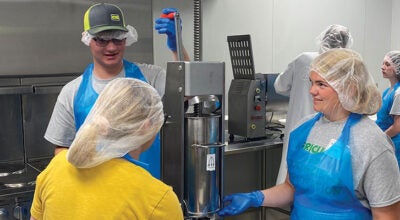Riverland reduces carbon footprint, costs
Published 8:47 am Friday, October 7, 2011
Last month, Riverland started a new initiative to reduce energy usage and establish goals to reduce our carbon footprint and energy costs in our communities.
This initiative, called “Sustain Riverland,” is another at Riverland’s efforts to be good stewards of the taxpayer’s money. We believe stretching dollars and scarce resources further and still being effective and efficient is a worthy goal.
Riverland officials have been working for several years on cost-cutting initiatives that conserve energy. In fact, the college has reduced its energy use 6 to 13 percent since 2007 in all Riverland buildings, saving $49,500 annually. Judy Enright, Riverland’s facilities manager, leads the “Sustain Riverland” committee. This committee, open to all interested employees, students and community members, intends to increase the college’s efforts as well as educate and inspire us all to “Recycle, Conserve and Change” through simple every-day efforts. For example, we currently ask Mower County Recycling to pick up plastic bottles three or four times each year. With the installation of additional containers and the new “Sustain Riverland” initiative, we plan to be part of their weekly route. We estimate this single effort could yield more than $4,000 savings per year.
One of the more ambitious goals of the new “Sustain Riverland” initiative is to cut down on garbage costs and increase recycling. The Austin campus alone dumps as much as 28 cubic yards of garbage twice a week, while only 16 cubic yards are recycled once a week. Riverland plans to recycle more and dump less to reduce costs.
Among Riverland’s goals are to further reduce yearly energy costs by 2 percent at its campuses in Albert Lea, Austin and Owatonna to save an additional $1,000 annually.
Riverland is also currently participating in an extensive energy audit provided by the Public Buildings Enhanced Energy Efficiency Program to learn specific ideas and gather cost estimates on mechanical and electrical projects that will conserve energy and save money. The “Sustain Riverland” committee plans to take these recommendations, prioritize them by cost and potential return, and align them with the college’s facilities operating budget.
“Sustain Riverland” is yet another successful way Riverland is streamlining our efforts to save costs. These savings will be invested in educational programming and in a better campus learning environment.
Riverland’s energy-saving strategies:
•Replacing the Austin East Building’s aging windows and doors with more energy-efficient models.
•Retrofitting all lighting fixtures in Riverland buildings from T-12 to T-8 fluorescent bulbs.
•Programming the computer labs to power off all devices at a specified time each day.
•Programming Energy Management systems according to room usage to avoid heating or cooling unoccupied building spaces.
•Installing occupancy motion sensors in classrooms, office suites and placing Energy Misers on vending machines to help reduce energy costs.
•Programming the Austin East Building parking lot lights to go off six hours each night, 365 days per year saving an additional $875.




